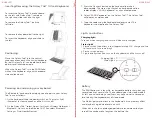
Optional Interfaces
Page 132
4 Set any switches and jumpers on the board as described in the
interface board’s manual. If your board has a jumper labeled JG, make
sure that you set it to ON, or the board will not work properly.
5 Slide the interface board
along the slots on both sides
of the compartment. Push it
in firmly to fully insert the
board’s connector into the
printer’s internal socket.
6 Secure the interface board in
the slot with the two screws
included with the board.
7 Connect the proper interface
cable to the interface board
and to your computer. If the cable has a grounding wire, connect it to
one of the screws securing the parallel interface.
If you are using more than one computer, reconnect the other interface
cable as well.
8 Make sure the printer is turned off. Then plug in the power cord.
In most cases, the printer automatically detects the interface you’re using.
However, if you have trouble printing through an installed interface board,
you may need to change the printer’s I/F (interface) mode setting. See
“Using Your Printer with DOS” in your
Printer Basics book.
To remove the interface board, follow steps 1 and 2 in this section.
Remove the screws securing the board and carefully pull it out of the
internal printer socket. Then replace the interface cover and screws you
removed in step 3.
color900.book Page 132 Wednesday, January 6, 1999 12:39 PM
















































